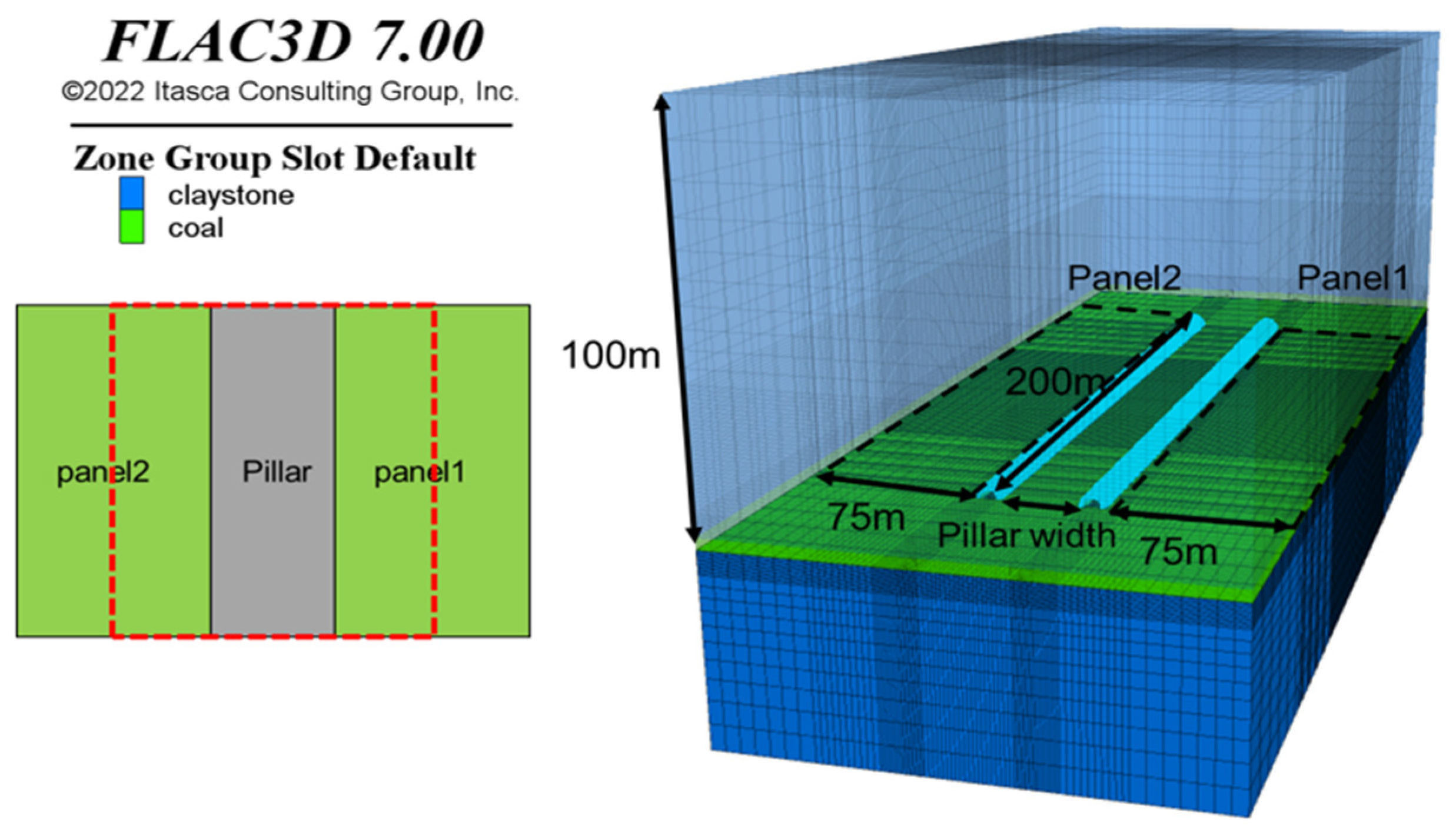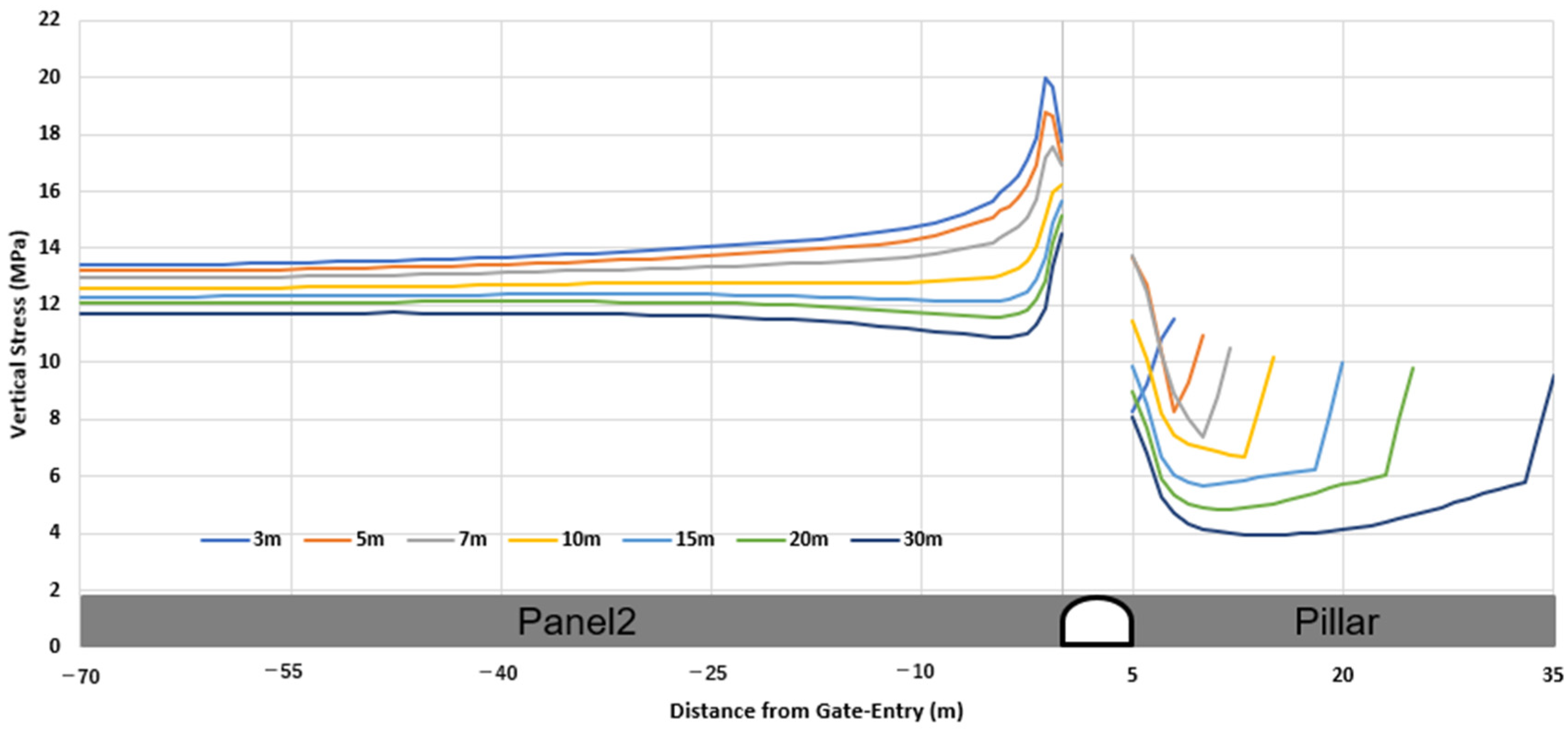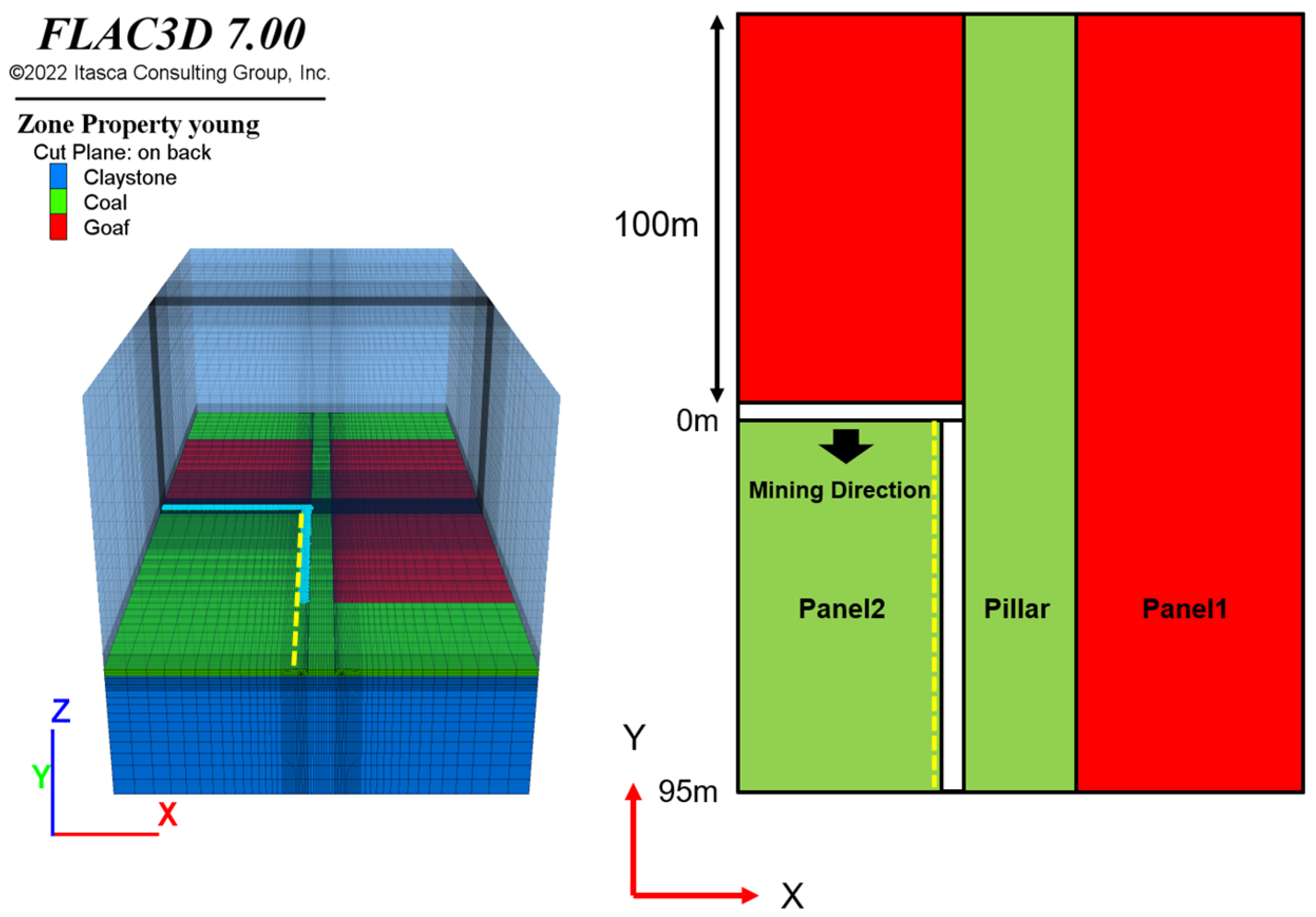Numerical Simulation on Pillar Design for Longwall Mining under Weak Immediate Roof and Floor Strata in Indonesia
Abstract
:1. Introduction
2. Numerical Model
2.1. Global Model Description
2.2. Modeling of Goaf
2.3. Modeling of Steel Arch and Powered Support
2.4. Model Validation
3. Result and Discussion
3.1. Pillar Design Based on Safety Factor
- Obert-Duvall equation
- Holland-Gaddy equation
- Bieniawski equation
3.2. Pillar Design Based on the Stability of Longwall Face
3.3. Influence of Immediate Roof/Floor Rock Strength on Pillar Design
4. Conclusions
- The stress acting on the pillar is reduced with increasing pillar width. The vertical stress in the pillar showed 13.75 MPa for a 5 m pillar width, 11.46 MPa for a 10 m pillar width, and 8.05 MPa for a 30 m pillar width.
- When the pillar width is 10 m, the safety factors for the pillar, when applying the Obert-Duvall, Holland-Gaddy, and Bieniawski equations, are 1.51, 1.82, and 1.83, respectively. It means that a pillar width of 10 m or more is needed if the required safety factor is in the range of 1.5~2.0.
- The increased pillar width significantly improves the stability of the roof and floor of the panel adjacent to the extracted panel. In the case of a pillar width of 10 m, the failure zone of the roof is reduced dramatically, but the entire floor fails. In the case of the pillar width of 20 m, the failure area decreases in the range where the load was applied by the powered support on both the roof and floor.
- There is a slight stability improvement due to the powered support setting load. The design of the pillar width has a more significant impact on improving the stability of the longwall face.
- Pillar design should consider the influence of the extracted neighboring panels on longwall face stability if the immediate roof/floor rock is weaker than the coal seam.
Author Contributions
Funding
Institutional Review Board Statement
Informed Consent Statement
Data Availability Statement
Acknowledgments
Conflicts of Interest
References
- Agus, C.A.; Farida, L.; Anton, B.P.; Vony, M.S.; Imam, G.A.; Dini, A.; Herlina, Y. Handbook of Energy and Economic Statistic of Indonesia; Kementerian ESDM RI: Jakarta, Indonesia, 2019. [Google Scholar]
- Brady, B.; Brown, E. Longwall and Caving Mining Methods Rock Mechanics for Underground Mining; Springer: Berlin/Heidelberg, Germany, 2007; pp. 430–483. [Google Scholar]
- Hsiung, S.M.; Syd, S.P. Chain pillar design for US longwall panels. Min. Sci. Technol. 1985, 2, 279–305. [Google Scholar] [CrossRef]
- Sinha, S.; Walton, G. Investigation of longwall headgate stress distribution with an emphasis on pillar behavior. Int. J. Rock Mech. Min. Sci. 2019, 121, 104049. [Google Scholar] [CrossRef]
- Klemetti, T.M.; Van Dyke, M.A.; Tulu, I.B.; Tuncay, D. A case study of the stability of a non-typical bleeder entry system at a US longwall mine. Int. J. Min. Sci. Technol. 2020, 30, 25–31. [Google Scholar] [CrossRef] [PubMed]
- Yang, R.; Zhu, Y.; Li, Y.; Li, W.; Lin, H. Coal pillar size design and surrounding rock control techniques in deep longwall entry. Arab. J. Geosci. 2020, 13, 1–14. [Google Scholar] [CrossRef]
- Qian, D.; Zhang, N.; Shimada, H.; Wang, C.; Sasaoka, T.; Zhang, N. Stability of goaf-side entry driving in 800-m-deep island longwall coal face in underground coal mine. Arab. J. Geosci. 2016, 9, 1–28. [Google Scholar] [CrossRef]
- Ghosh, N.; Agrawal, H.; Singh, S.K.; Banerjee, G. Optimum chain pillar design at the deepest multi-seam longwall workings in India. Min. Metall. Explor. 2020, 37, 651–664. [Google Scholar] [CrossRef]
- Yu, B.; Zhang, Z.; Kuang, T.; Liu, J. Stress changes and deformation monitoring of longwall coal pillars located in weak ground. Rock Mech. Rock Eng. 2016, 49, 3293–3305. [Google Scholar] [CrossRef]
- Xu, Q.; Bai, J.B.; Yan, S.; Wang, R.; Wu, S. Numerical study on soft coal pillar stability in an island longwall panel. Adv. Civ. Eng. 2021, 2021, 8831778. [Google Scholar] [CrossRef]
- Sasaoka, T.; Takamoto, H.; Shimada, H.; Oya, J.; Hamanaka, A.; Matsui, K. Surface subsidence due to underground mining operation under weak geological condition in Indonesia. J. Rock Mech. Geotech. Eng. 2015, 7, 337–344. [Google Scholar] [CrossRef] [Green Version]
- Matsui, K.; Shimada, H.; Furukawa, H.; Kramadibrata, S.; Anwar, H. Ground control problems and roadheader drivage at Ombilin coal mine, Indonesia. In Proceedings of the 18th International Mining Congress and Exhibition of Turkey-IMCET, Antalya, Turkey, 10–13 June 2003. [Google Scholar]
- Sasaoka, T.; Shimada, H.; Lin, N.Z.; Takamoto, H.; Matsui, K.; Kramadibrata, S.; Sulistianto, B. Geotechnical issues in the application of rock bolting technology for the development of underground coal mines in Indonesia. Int. J. Min. Reclam. Environ. 2014, 28, 150–172. [Google Scholar] [CrossRef]
- Mao, P.; Hashikawa, H.; Sasaoka, T.; Shimada, H.; Wan, Z.; Hamanaka, A.; Oya, J. Numerical Investigation of Roof Stability in Longwall Face Developed in Shallow Depth under Weak Geological Conditions. Sustainability 2022, 14, 1036. [Google Scholar] [CrossRef]
- Sasaoka, T.; Mao, P.; Shimada, H.; Hamanaka, A.; Oya, J. Numerical analysis of longwall gate-entry stability under weak geological condition: A case study of an Indonesian coal mine. Energies 2020, 13, 4710. [Google Scholar] [CrossRef]
- Putri, R.H.K. Coal Pillar Strength Formula in Indonesian coal mines. J. Earth Mar. Technol. (JEMT) 2020, 1, 20–24. [Google Scholar] [CrossRef]
- Hoek, E.; Brown, E.T. Practical estimates of rock mass strength. Int. J. Rock Mech. Min. Sci. 1997, 34, 1165–1186. [Google Scholar] [CrossRef]
- Yavuz, H. An estimation method for cover pressure re-establishment distance and pressure distribution in the goaf of longwall coal mines. Int. J. Rock Mech. Min. Sci. 2004, 41, 193–205. [Google Scholar] [CrossRef]
- Cheng, Y.; Wang, J.A.; Xie, G.X.; Wei, W.B. Three-dimensional analysis of coal barrier pillars in tailgate area adjacent to the fully mechanized top caving mining face. Int. J. Rock Mech. Min. Sci. 2010, 47, 1372–1383. [Google Scholar] [CrossRef]
- Salamon, M.D.; Munro, A.H. A study of the strength of coal pillars. J. S. Afr. Inst. Min. Metall. 1967, 68, 55–67. [Google Scholar]
- Bieniawski, Z.T. Rock Mechanics Design in Mining and Tunneling; U.S. Department of Energy Office of Scientific and Technical Information: Oak Ridge, TN, USA, 1984; pp. 183–216. [Google Scholar]
- Unver, B.A.H.T.I.Y.A.R.; Yasitli, N.E. Modelling of strata movement with a special reference to caving mechanism in thick seam coal mining. Int. J. Coal Geol. 2006, 66, 227–252. [Google Scholar] [CrossRef]













| Density (kg/m3) | Young’s Modulus (MPa) | Poisson’s Ratio (−) | Cohesion (MPa) | Friction Angle (°) | Compressive Strength (MPa) | |
|---|---|---|---|---|---|---|
| Claystone | 2110 | 800 | 0.28 | 0.60 | 37.5 | 4.84 |
| Coal | 1380 | 1300 | 0.32 | 2.63 | 45.6 | 8.16 |
| Goaf | 1700 | 15 | 0.25 | 0.001 | 25.0 | - |
| Lithology | UCS (MPa) | c1 | c2 |
|---|---|---|---|
| Strong | >40 | 2.1 | 16 |
| Medium | 20–40 | 4.7 | 19 |
| Weak | <20 | 6.2 | 32 |
| Density (kg/m3) | Young’s Modulus (MPa) | Poisson’s Ratio (−) | Cross-Sectional Area (cm2) | Yield Strength (MPa) | Polar Moment of Inertia (10−8 m4) |
|---|---|---|---|---|---|
| 7800 | 200 | 0.3 | 36.5 | 540 | 22 |
| 3 m | 5 m | 7 m | 10 m | 15 m | 20 m | 30 m | |
|---|---|---|---|---|---|---|---|
| Obert-Duvall Equation | 0.82 | 0.86 | 1.06 | 1.51 | 2.27 | 3.10 | 4.90 |
| Holland-Gaddy Equation | 0.82 | 0.92 | 1.25 | 1.82 | 2.69 | 3.54 | 5.16 |
| Bieniawski equation | 0.82 | 0.93 | 1.21 | 1.83 | 2.94 | 4.17 | 6.92 |
| Density (kg/m3) | Young’s Modulus (MPa) | Poisson’s Ratio (−) | Cohesion (MPa) | Friction Angle (°) | Compressive Strength (MPa) | |
|---|---|---|---|---|---|---|
| Claystone 1 (Study mine) | 2110 | 800 | 0.28 | 0.60 | 37.5 | 4.84 |
| Claystone 2 (Referred mine) | 2345 | 5520 | 0.26 | 2.63 | 47 | 29.2 |
Publisher’s Note: MDPI stays neutral with regard to jurisdictional claims in published maps and institutional affiliations. |
© 2022 by the authors. Licensee MDPI, Basel, Switzerland. This article is an open access article distributed under the terms and conditions of the Creative Commons Attribution (CC BY) license (https://creativecommons.org/licenses/by/4.0/).
Share and Cite
Hashikawa, H.; Mao, P.; Sasaoka, T.; Hamanaka, A.; Shimada, H.; Batsaikhan, U.; Oya, J. Numerical Simulation on Pillar Design for Longwall Mining under Weak Immediate Roof and Floor Strata in Indonesia. Sustainability 2022, 14, 16508. https://doi.org/10.3390/su142416508
Hashikawa H, Mao P, Sasaoka T, Hamanaka A, Shimada H, Batsaikhan U, Oya J. Numerical Simulation on Pillar Design for Longwall Mining under Weak Immediate Roof and Floor Strata in Indonesia. Sustainability. 2022; 14(24):16508. https://doi.org/10.3390/su142416508
Chicago/Turabian StyleHashikawa, Hiroto, Pisith Mao, Takashi Sasaoka, Akihiro Hamanaka, Hideki Shimada, Ulaankhuu Batsaikhan, and Jiro Oya. 2022. "Numerical Simulation on Pillar Design for Longwall Mining under Weak Immediate Roof and Floor Strata in Indonesia" Sustainability 14, no. 24: 16508. https://doi.org/10.3390/su142416508





